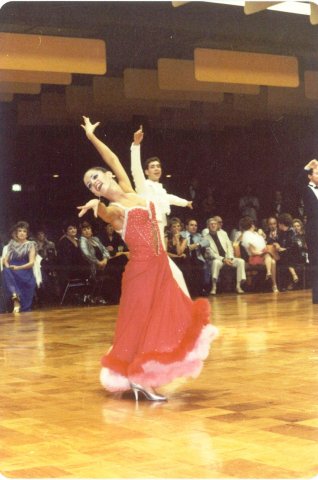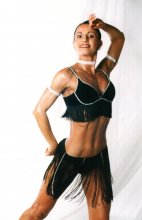You are here
Home ›Ballroom Dancing: Sport, Hobby or Recreation?

As a child growing up in Nelson BC, I remember spending many Sunday afternoons watching old black & white movies of Fred Astaire and Ginger Rogers. As they graced the dance floor with amazing form and splendor, chills would run up my spine as I watched them in awe. Oh, how I wished I too, could dance like that. Well, dreams do come true!
I’ve enjoyed a wonderful professional career in Ballroom Dancing. I’ve competed successfully throughout North America, performing with some of the world’s finest dancers, the real "creme de la creme" of the industry. Today, I teach the sport to individuals and large groups of men, women and children.
Through all my dancing experiences, I’ve always believed "Once a dancer always a hard worker." Dancing, no matter which style, is a discipline. A discipline which demands good technique and develops posture, balance and poise. Dancing improves both mental and physical coordination and is recognized as a distinct form of social recreation. It combines a terrific form of physical activity with plenty of fun, and is a great way to make new friends.
Based on International Standards, ballroom dancing includes the Waltz, Foxtrot, Tango, Quickstep, and Viennese Waltz. The Latin American dances include the Rumba, Cha Cha, Samba, Paso Doble and Jive. In addition, American Style dance forms, such as the West Coast Swing, Mambo, Salsa, Merengue and Street Hustle (Disco) have also received International acceptance. Each of these dances require a partner in which the male leads and the female follows.
The standardization of basic steps and technique in ballroom dancing has resulted in an International Syllabus that is applicable worldwide. Its multinational interest and recent surge in popularity, achieved without much publicity, has led to its recognition as a great indoor sport and recreation. Ballroom dancing is a wonderful pastime and attracts many committed athletes. As a result, it is rapidly achieving the status of a competitive sport.

To become a comfortable social dancer requires expert instruction and regular practice. Once this level is achieved, a dancers performance tends to escalate with continued involvement, and it is not uncommon for beginners to become more competitive in a relatively short period of time. The pleasure of executing steps correctly with good poise, posture and rhythm will more than compensate for the time it takes to learn them.
For many participants, ballroom dancing is a hobby which provides a pleasant means of obtaining healthy physical activity in a non-smoking, non-alcoholic environment. The heart and lungs receive aerobic stimulation which improves stamina and endurance. The back muscles become stronger, and the legs, ankles and feet adapt with improved condition.
On a mental level, one must memorize dance patterns, coordinate body movement with musical rhythm and learn intricate leads & follows. In general, this activity is a full-body toner and creates a positive mental attitude.
Besides the physical aspect, dancers also learn the importance of social protocol and etiquette. This will help the student feel more at ease in any social situation. For those with more ambition, the next step involves training for bronze, silver and gold level metal examinations or competing in amateur dance competitions held locally and internationally.
What about ballroom dancing as a sport? Webster’s dictionary defines sport as any activity or experience that requires bodily exertion and gives enjoyment or recreation. If figure skating or diving can rate as an Olympic sport, then why not ballroom dancing? A study by the Freiburg University in Germany, showed that a vigorous Rumba requires the same exertion as a foot or bicycle race over a similar period of time and burns the same number of calories (330 per hour). The International Dance Sport Federation (IDSF) is currently lobbying the International Olympic Committee (IOC) to include the Waltz alongside the pole vault.
Try dancing a Quickstep around a large ballroom floor and tell me that isn’t a workout! Nonetheless, if you enjoy music, glamour, and socializing , or have pondered the thought of taking ballroom dance lessons, here’s where to look. Community centers, private dance studios, or independent dance instructors in your city offer a wide variety of private lessons, group classes, and practice sessions. For your convenience, day or evening classes are offered, which is great for shift workers. Classes are conducted for juveniles to seniors. One is never too young or too old to get started.
When I teach my students, I encourage them to drink plenty of filtered water. This prevents dehydration which combats fatigue and keeps the mind alert. I have seen many top competitive dancers munch on garbage food for a quick pick up. I suggest a sports nutrition bar as a healthy alternative or a protein shake for muscle strength and endurance. This can be made in advance and taken to the practice session.
As a social recreation, you will come in close contact with many people. Proper hygiene is essential and students are advised to keep themselves well groomed. I recommend a good vitamin program which includes a multi-vitamin & mineral with extra C & E. This helps boost the immune system and prevents some of the muscle soreness caused by the physical activity.
Ballroom dancing has helped me to stay lean, poised and well groomed. I have also discovered that weight training and good nutrition are important allies that keep me in top shape as a professional in this field. Don’t put it off any longer. Get dancing and I’ll see you on the dance floor.

Every Day's a Holly-Day!
TKH
- Log in to post comments